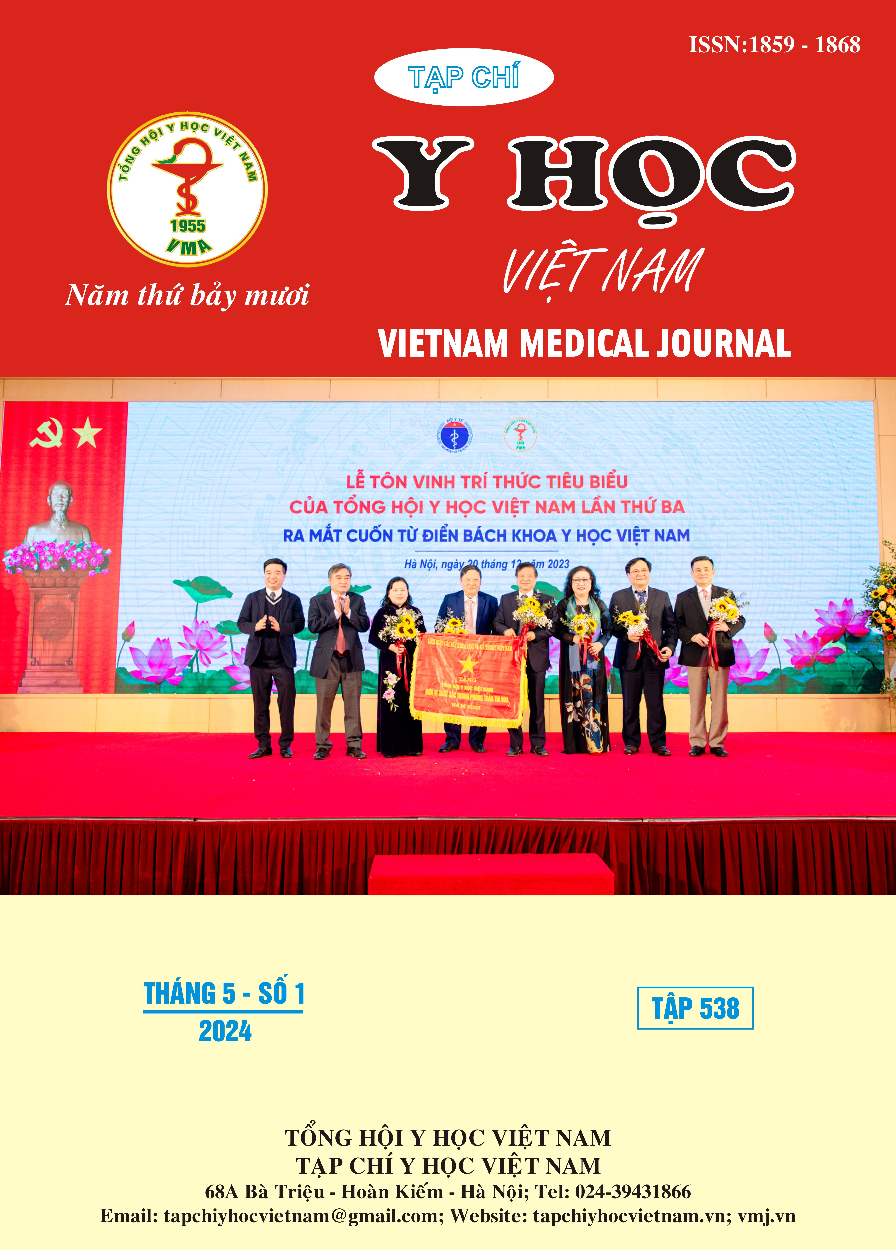KẾT QUẢ ĐIỀU TRỊ BƠM XI MĂNG CÓ BÓNG TẠO HÌNH THÂN ĐỐT SỐNG VỚI ĐƯỜNG VÀO NGOÀI CUỐNG TRÊN BỆNH NHÂN XẸP ĐỐT SỐNG NGỰC DO LOÃNG XƯƠNG
Nội dung chính của bài viết
Tóm tắt
Mục tiêu: Mô tả kết quả điều trị bơm xi măng có bóng tạo hình thân đốt sống với đường vào ngoài cuống trên bệnh nhân xẹp đốt sống ngực do loãng xương. Đối tượng và phương pháp nghiên cứu: Mô tả tiến cứu 48 bệnh nhân xẹp đốt sống ngực do loãng xương được điều trị bằng phương pháp bơm xi măng có bóng tạo hình thân đốt sống với đường vào ngoài cuống tại Bệnh viện Việt Đức. Kết quả: 48 bệnh nhân (15 nam, 33 nữ) với độ tuổi trung bình 68,41 ± 8,21 (64 – 93 tuổi) được chẩn đoán xẹp đốt sống ngực do loãng xương, được điều trị bằng bơm xi măng tạo hình thân đốt sống với đường vào ngoài cuống. Tỷ lệ xẹp 1 đốt sống là 79,17%, xẹp 2 đốt sống là 20,83%. Người bệnh chủ yếu xẹp đốt sống độ 2 và độ 3 theo phân loại OF với tỷ lệ lần lượt là 68,9%% và 27,7%. 58 đốt sống ngực bị xẹp được bơm xi măng, lượng xi măng trung bình được bơm vào thân đốt sống là 3,06 ±1,26ml. Tỷ lệ ngấm xi măng trên 2/3 thân đốt chiếm 62,1%, tỷ lệ ngấm xi măng dưới 1/3 thân đốt chiếm tỷ lệ 6,9% và tỷ lệ ngấm xi măng từ 1/3-2/3 thân đốt sống chiếm 31,0%. Tỷ lệ tràn xi măng qua bờ trước thân đốt sống chiếm 13,8%, 8,6% tràn vào đĩa đệm và 3,4% tràn vào mạch máu trước thân đốt sống. Không có mối liên quan giữa mức độ xẹp đốt sống với kết quả phẫu thuật sau. Điểm VAS trung bình trước bơm xi măng là 7,22 ± 1,17; sau 24 giờ là 1,67 ± 0,57; tại thời điểm khám lại là 0,86 ± 0,16. Theo phân loại của MacNab, sau phẫu thuật bệnh nhân đạt kết quả tốt và khá chiếm 95,8%, trung bình chiếm 4,2%, không có bệnh nhân đạt kết quả kém. Kết luận: Bơm xi măng đốt sống ngực với đường vào ngoài cuống là phương pháp điều trị an toàn, ít nguy cơ tai biến, biến chứng, hiệu quả giảm đau nhanh, cải thiện được tốt chức năng vận động, nâng cao được chất lượng cuộc sống cho bệnh, phù hợp với người cao tuổi.
Chi tiết bài viết
Từ khóa
tạo hình thân đốt sống, xẹp đốt sống, loãng xương.
Tài liệu tham khảo
2. Garnier L, Tonetti J, Bodin A, et al. Kyphoplasty versus vertebroplasty in osteoporotic thoracolumbar spine fractures. Short-term retrospective review of a multicentre cohort of 127 consecutive patients. Int Orthop. 2012;98:S112-S119.
3. Wardlaw D, Cummings SR, Van Meirhaeghe J, et al. Efficacy and safety of balloon kyphoplasty compared with non-surgical care for vertebral compression fracture (FREE): a randomised controlled trial. Lancet. 2009; 373:1016-1024.
4. Leech JA, Dulberg C, Kellie S, et al. Relationship of lung function to severity of osteoporosis in women. Am Rev Respir Dis. 1990;141:68-71.
5. McLain RF, Ferrara L, Kabins M. Pedicle morphometry in the upper thoracic spine: limits to safe screw placement in older patients. Spine (Phila Pa 1976). 2002;27:2467-2471.
6. Dvorak M, MacDonald S, Gurr KR, et al. An anatomic, radiographic, and biomechanical assessment of extrapedicular screw fixation in the thoracic spine. Spine (Phila Pa 1976). 1993;18: 1689-1694.
7. Husted DS, Yue JJ, Fairchild TA, et al. An extrapedicular approach to the placement of screws in the thoracic spine: an anatomic and radiographic assessment. Spine (Phila Pa 1976). 2003;28:2324-2330.
8. Han KR, Kim C, Eun JS, et al. Extrapedicular approach of percutaneous vertebroplasty in the treatment of upper and mid-thoracic vertebral compression fracture. Acta Radiol. 2005;46: 280-287.
9. Ge Z, Ma R, Chen Z, et al. Uniextrapedicular kyphoplasty for the treatment of thoracic osteoporotic vertebral fractures. Orthopedics. 2013;36: e1020-e1024.
10. Ryu KS, Park CK, Kim MK, et al. Single balloon kyphoplasty using far-lateral extrapedicular approach: technical note and preliminary results. J Spinal Disord Tech. 2007;20:392-398.


